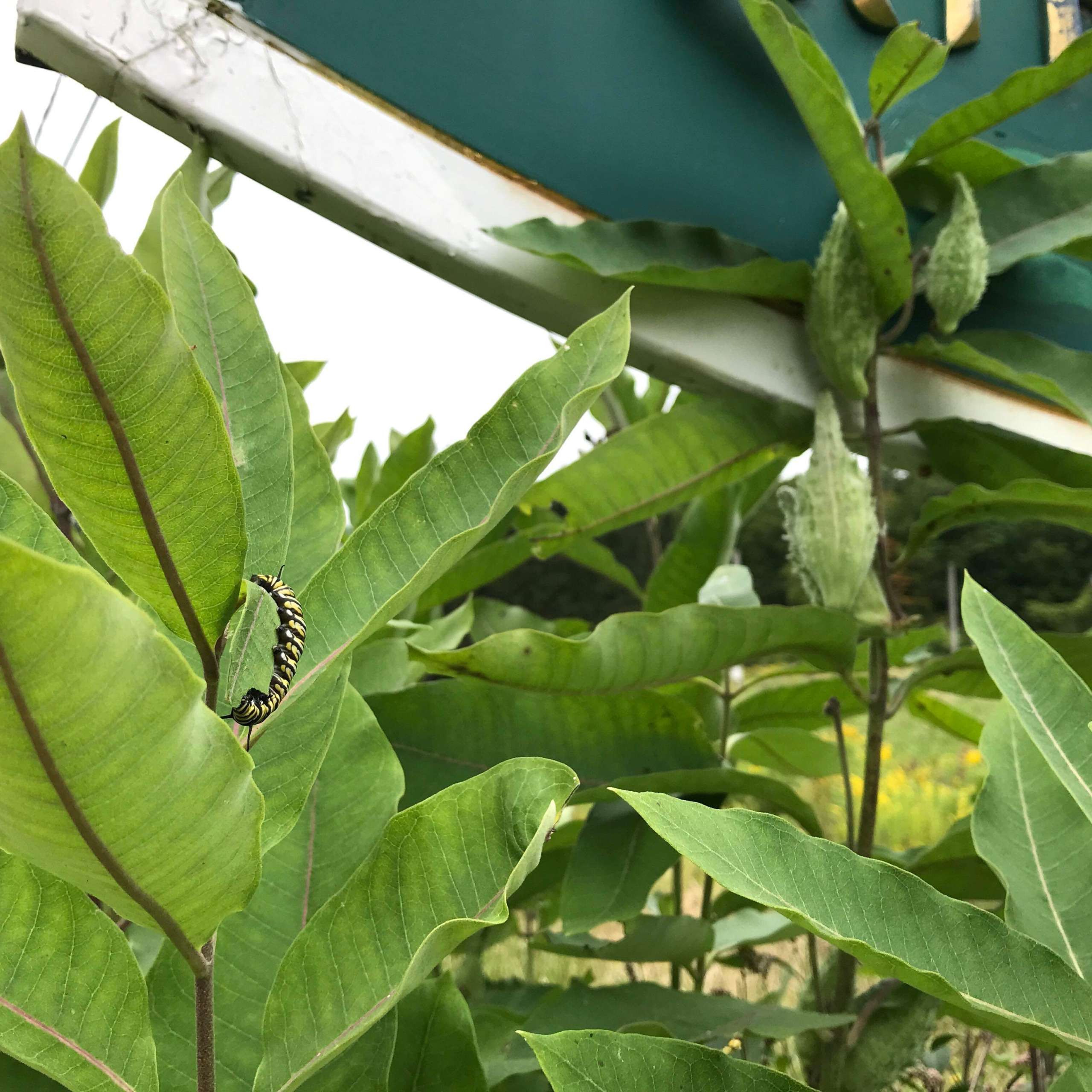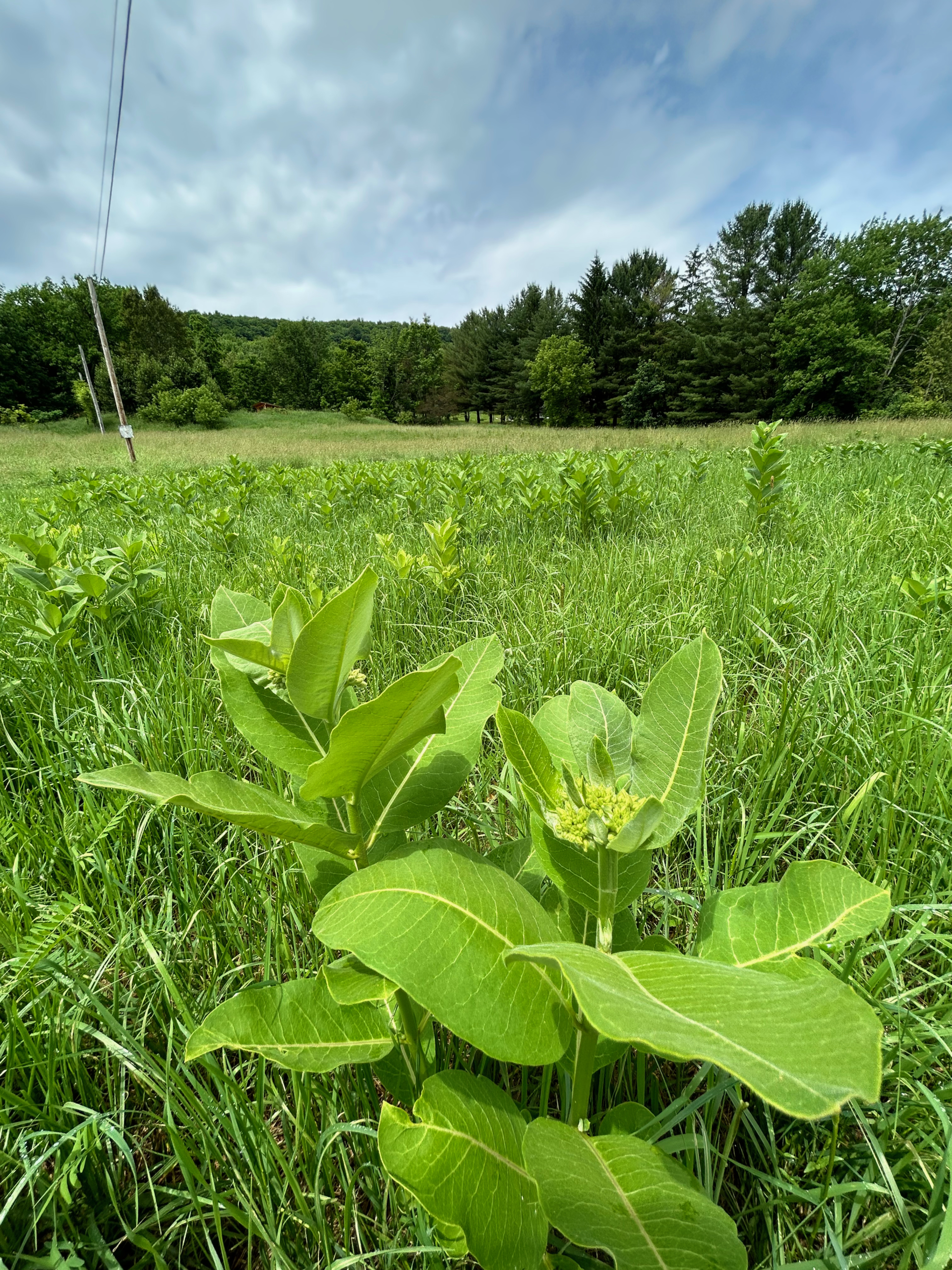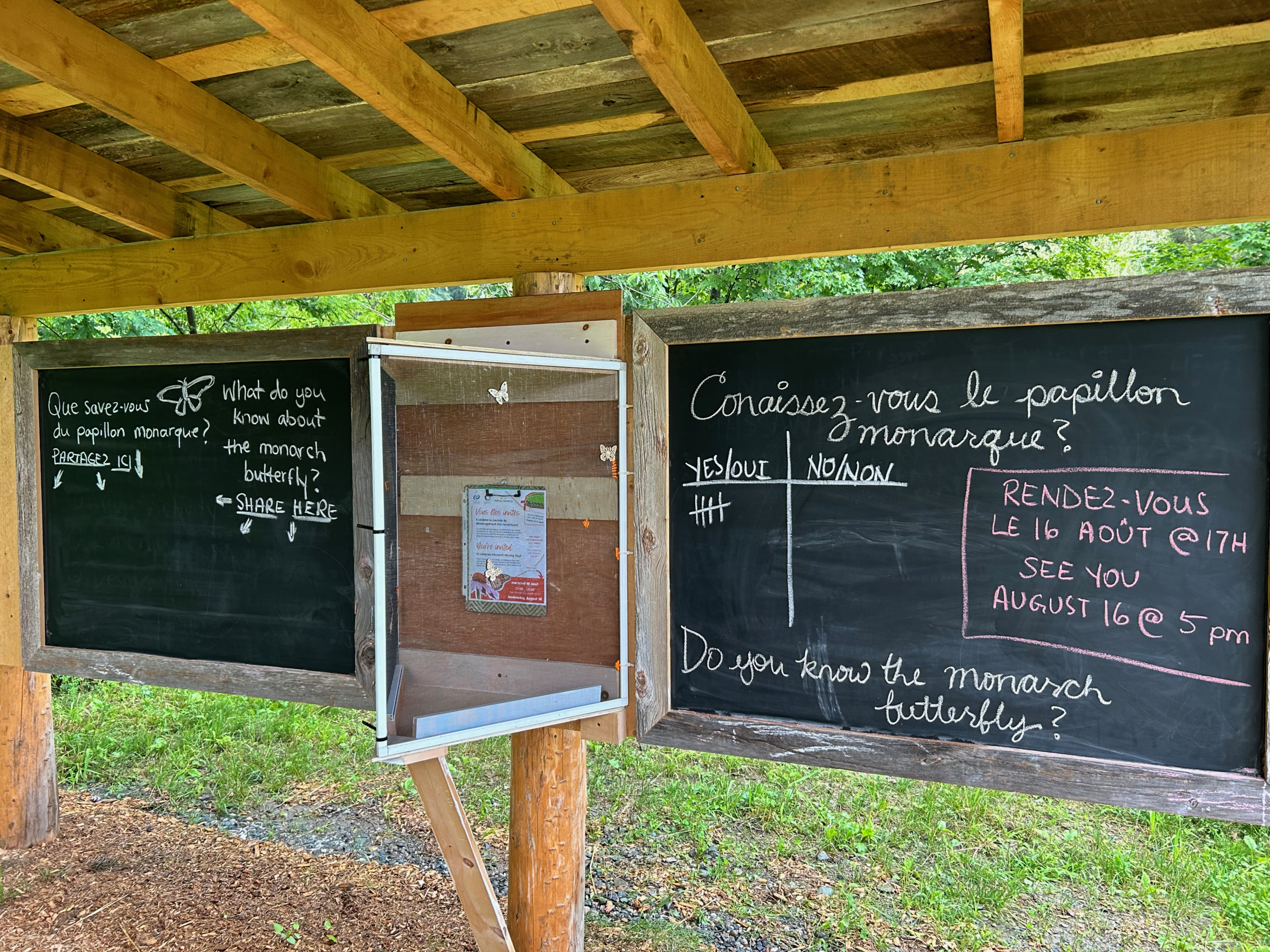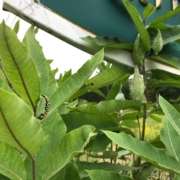Written by Jessica Adams (Nature Nerding)
Reading time: 5-6 minutes

(Ph: Guillaume Levesque) Though we didn’t have any luck finding Monarch eggs or caterpillars at Scowen, following our “Monarch Moving Day”, Guillaume Levesque and his family spotted this little one. In his own words: “It’s interesting because it was on the [milkweed] plant closest to the road! Thank you for sharpening our observation skills!”.
The Massawippi Foundation’s Monarch Butterfly project, coordinated by Nature Nerding, took place for the first time this year starting in July. Our overarching goals were to: bring awareness to the fields of milkweed at the entrance to Scowen Park, collect data on the presence of Monarchs at Scowen and momentarily capture and share the wonder of a metamorphosing butterfly by installing a live exhibit in the form of a butterfly nursery. We could not be happier with how things unfolded.
Recap: Why a Monarch Butterfly Project?
The Monarch Butterfly (Danaus plexippus) has experienced an 80% decline in numbers over the last couple of decades and has been designated as Endangered. It is hardly the only insect of value in an ecosystem and sadly, it is far from the only insect facing challenges. However, from a conservation standpoint, there is a rationale behind choosing to shine the spotlight on certain key species.
In the case of Monarchs, there are a couple of reasons. Firstly, they are considered an umbrella species which means taking action to protect Monarchs can have an impact on various other species sharing the same habitat or some of the same requirements for survival. Secondly – and most of us who have had the privilege of getting acquainted with them can attest – Monarchs evoke genuine fascination. From their stunning colouration and complex life cycle to their epic migration down South, we are compelled to learn more about this charismatic species and be a part of protecting them. Together, these elements make Monarchs the perfect “spokes-insects” for raising awareness of and encouraging participation in conservation efforts for smaller wildlife.
The Butterfly Brigade & the Monarch Life Cycle
Our first Butterfly Brigade (BB) meeting was held early in July and a handful of dedicated volunteers continued to meet every two weeks for the next two months to see the project through.
Home to various species of native wildflowers, the lower fields flanking the entrance to the Scowen Park trails constitute an incredibly valuable habitat for a variety of wildlife. The abundance of milkweed in these fields is of particular interest as this humble plant is critical to the Monarch Butterfly lifecycle. And so in our first meeting, we began by learning how to recognize milkweed.
 This is a focal point of the project since it is the only plant a Monarch caterpillar will feed on making it essential for Monarch reproduction. Though there are several species of milkweed, the only species present at Scowen is Common Milkweed (Asclepias syriaca). After taking inventory of what Common Milkweed looks, feels, and smells like, we proceeded to mark a handful of data collection sites throughout the fields.
This is a focal point of the project since it is the only plant a Monarch caterpillar will feed on making it essential for Monarch reproduction. Though there are several species of milkweed, the only species present at Scowen is Common Milkweed (Asclepias syriaca). After taking inventory of what Common Milkweed looks, feels, and smells like, we proceeded to mark a handful of data collection sites throughout the fields.
At our next meeting, we learned more about the Monarch life cycle and how to go about collecting data. Because Monarch caterpillars feed exclusively on milkweed, adult butterflies lay their eggs on this plant. There is typically one egg per plant and most often the egg can be found on the underside of the velvety leaves. Roughly the size of a pinhead, these eggs can be hard to detect and are easily confused with other things such as globs of congeled milkweed sap. Needless to say, collecting data required keen observation and a significant amount of patience!
Despite the abundance of milkweed at Scowen, we were surprised and slightly disappointed to find no eggs and no caterpillars (larvae) in several weeks of scouring the plants at our study sites. We wondered why that was. Had we simply overlooked the eggs because they were so tiny? Was something predating the eggs and caterpillars? Was there something else at work making this breeding ground less favourable than we had hoped? Though we were perplexed, we reminded ourselves that recording the absence of Monarchs was important data nonetheless. And so we carried on completing our Observation Forms (courtesy of Espace pour la vie’s Mission Monarch), data we would later upload to their database.
In August, we turned our attention to the installation of a nursery under the shelter at the park. Made entirely out of recycled materials, this screen structure was installed early in the month with the intention of having at least one caterpillar move in. Due to the fact we did not come across any monarch caterpillars at Scowen, we decided to “import” a caterpillar from the Brome Lake area. We highlighted this event as “Monarch Moving Day” and invited the public to attend to celebrate with us as we set our special guest up in his very own nursery, fresh milkweed sprigs and all.
We had members of the BB visiting the nursery every day thereafter to keep tabs on how things were going. Once moved in, the caterpillar kept busy feeding on milkweed while leaving impressively large quantities of frass on the nursery floor. A couple of days later, he had inched his way up to the roof of the nursery and just a day after that, was suspended from the roof, ready to pupate. By Sunday, August 20, we officially had a chrysalis!
The pupa stage “lasts eight to fifteen days under normal summer conditions” (monarchjointventure.org). You may recall the cool spell we experienced later in August and our little friend certainly seemed to have noticed as well! He stayed cozy in his chrysalis until a total of 18 days later when he emerged as a healthy adult butterfly (at this point, we were able to confirm he was a male based on the dark spots on his hind wings). He was released, free to forage on the nectar from a variety of wildflowers, all in preparation for his long journey south to Mexico.
The Role of the Nursery
When discussing the various components of the project, the following (and very valid) question was raised: What is the point of a nursery?
 Human intervention can be a contentious topic when it comes to conservation efforts. How can we be certain we are doing more good than harm? Are we preventing nature from “taking its course”? These questions can be debated at length and conclusions are typically drawn on a case-by-case basis.
Human intervention can be a contentious topic when it comes to conservation efforts. How can we be certain we are doing more good than harm? Are we preventing nature from “taking its course”? These questions can be debated at length and conclusions are typically drawn on a case-by-case basis.
Simply put, the main goal of the Scowen Park nursery was to share the wonder. By creating a location where at least one Monarch could complete metamorphosis undisturbed, we were able to showcase the fascinating intricacies of this living being’s lifecycle. We were able to display and honour a small piece of the natural magic happening all around us.
Whether folks were closely following the project or only catching glimpses here and there, “wow moments” were had. This may seem trivial, but these “wow moments” are powerful. They are the foundation for gradually developing a sense of concern for the species with whom we coexist. Naturally, this sense of concern can have an impact on shaping our values and attitudes towards the natural world, trickling down into our everyday habits. While it is not a direct, linear path, it is a very natural one and is based on the premise that we tend to protect what we love… and we can only love what we know.
Taking in the pleasant smell of a milkweed flower for the first time, learning about the relationship between milkweed and Monarch caterpillars, catching glimpses of other neat invertebrate life on milkweed plants, watching a caterpillar pupate in real time, seeing a chrysalis for the first time, discovering you’ve been confusing Viceroy Butterflies (Limenitis archippus) for Monarch Butterflies this whole time… This project provided countless opportunities for learning, for wonder and for creating a closer connection with the natural world.
On a final note, we would like to recognize the immense value of the information and resources made available (for free) by Mission Monarch (Espace pour la vie), Monarch Joint Venture and the Butterflyway Project (David Suzuki Foundation). The overall project also relied heavily on the contributions of our super team of “Butterfly Brigade” volunteers who devoted hours to data collection and nursery surveillance, among other things. We are so grateful for every aspect of this year’s first Monarch Butterfly Project and eagerly anticipate its continuation in 2024!
Build Your Nature Vocabulary
Use the text and search the web to build your nature vocabulary and try using it the next time you’re out and about in nature, either making observations by yourself or with friends!
- Endangered
- Umbrella Species
- Larvae
- Frass
- Pupate
References
- Monarch Joint Venture (https://monarchjointventure.org/)
- David Suzuki Foundation Butterflyway Project (davidsuzuki.org)
- Espace pour la vie – Mission Monarch (https://www.mission-monarch.org/)



